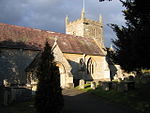Wildmoorway Meadows
English Site of Special Scientific Interest stubsMeadows in GloucestershireSites of Special Scientific Interest in GloucestershireSites of Special Scientific Interest notified in 1989

Wildmoorway Meadows (grid reference SU066973) is a 12.6-hectare (31-acre) biological Site of Special Scientific Interest in Gloucestershire, to the east of Fairford, notified in 1989. The site is listed in the 'Cotswold District' Local Plan 2001-2011 (on line) as a Key Wildlife Site (KWS).
Excerpt from the Wikipedia article Wildmoorway Meadows (License: CC BY-SA 3.0, Authors, Images).Wildmoorway Meadows
Cotswold District South Cerney
Geographical coordinates (GPS) Address Nearby Places Show on map
Geographical coordinates (GPS)
| Latitude | Longitude |
|---|---|
| N 51.674881 ° | E -1.905229 ° |
Address
GL7 5LT Cotswold District, South Cerney
England, United Kingdom
Open on Google Maps








